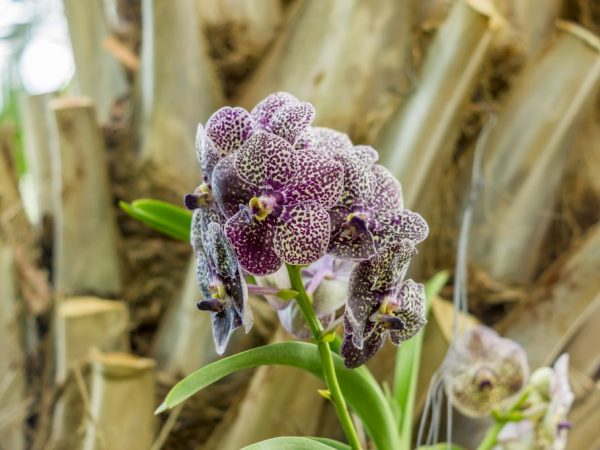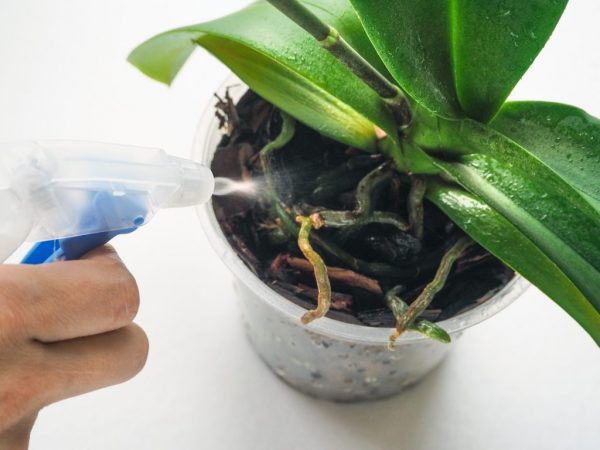Cleopatra Orchid - growing rules
There are several types of orchids, which are distinguished by a rare flower color. One of these varieties is the Cleopatra Phalaenopsis Orchid.

Growing orchid Phalaenopsis Cleopatra
Characteristics of the Cleopatra variety
The main distinguishing feature of the variety is its amazing color and long flowering period. The height of the stem reaches 65 cm. The length of the peduncle is not more than 48 cm. On each arrow there are medium-sized flowers, each of which is 8 mm in diameter.
Orchid color
The Cleopatra Orchid has one color. According to the description, purple spots of the same size and regular shape are arranged in an even order on a white sheet.
The density of the dots is different, the closer to the free edge, the greater their density. The heart of the flower has an unusual shape and is colored purple
Leaves and roots
The root system of gray-green or bright green is well developed. Leaves are dense, fleshy. Deep green, oval in shape and sharp corner at the end.
Growing varieties
Growing Phalaenopsis Cleopatra at home is possible, but it should be borne in mind that the variety is capricious, requires a certain amount of time and proper care.
Landing Cleopatra
An orchid is an epiphyte flower that lives off other plants.
To plant a variety, you should buy or prepare a special substrate and a pot. Phalaenopsis roots love sunlight and oxygen, so it is better to plant the plant in a transparent container with a lot of holes.
Cleopatra's roots grow wide, the pot should be shallow and not narrow. The bottom of the tank is filled with drainage (about 1.5 fingers) or river pebbles. Orchids are grown in two ways: by seed or sprout.
Seeds
Growing a flower with seeds is a painstaking process. A special box is pretreated, the prepared soil is filled in and the seed is planted. The container is tightly closed before the first sunrises. The orchid has a long period of growth and vegetation. After 1.5 - 2 years, the plant is transplanted into a special pot.
Rostkom
The sprout should have a weak root system, 3 - 5 leaves per column and an outwardly healthy appearance. They are planted in a prepared pot, having previously treated the roots with a nutrient solution. After planting, the plant is watered abundantly and normal plant care begins.
Orchid care

The flower loves moisture
Phalaenopsis needs proper care:
- Temperature conditions. The plant loves an average air temperature of 20 ° C to 25 ° C. At night, temperatures should not be higher than 18 ° C and not lower than 10 ° C. The orchid will not survive the frost or summer heat. It is necessary to avoid drafts, but do not forget to ventilate the room.
- A place. It should be light, but not in direct sunlight. The orchid dies from their influence. The pot should not stand over a hot radiator, otherwise the plant will dry out. The optimum air humidity is 70-80%.
- Fertilizing and feeding.The flower needs additional elements. Special ready-made mixtures for orchids will help.
- Water the plant regularly and correctly. She loves moisture. The average frequency of watering a flower is 1-2 times a month.
Pruning and replanting
Cleopatra, like other phalaenopsis, periodically needs a transplant. To do this, you must first prepare the pot, cut off the rotten roots and treat with a special solution. After that, you should place the flower in a new pot and continue with the usual care of the orchid.
Prune the orchid after all the buds have bloomed. Cut the flower stalks, this will help the plant to bloom next season.
Diseases and pests
The appearance of pests is possible due to improper care. Sunburn, excessive moisture, or an irregular pot can kill the plant.
Pest control
Orchid juice attracts many parasites. It is struck by: aphids, ticks, scale insects, etc. To avoid these troubles, you need to use special solutions and ready-made mixtures.
Prophylaxis
The best preventive work is proper care. Timely transplanting and pruning, proper watering and temperature regime will not give the plant a reason to worsen its condition.
Conclusion
Phalaenopsis Cleopatra orchid has high decorative qualities. Cleopatra, like other orchids, is capricious in her care. If all the requirements are met, the plant will live for a long period of time.


